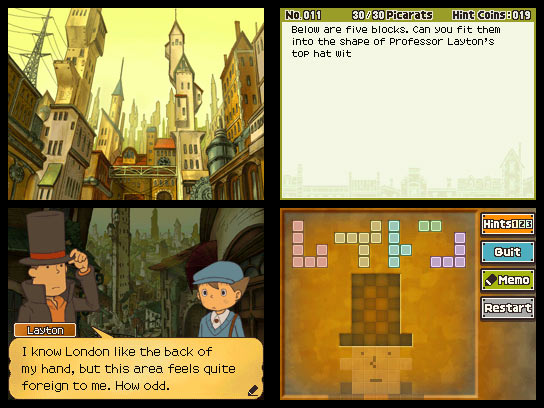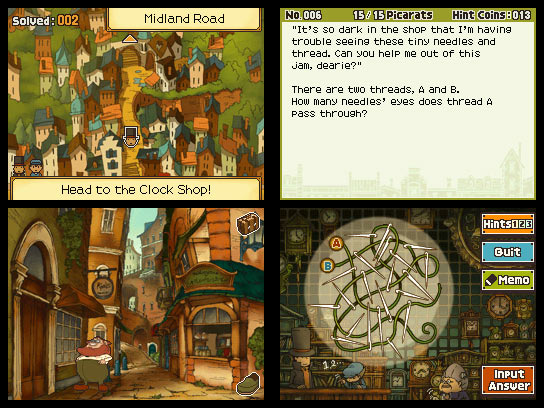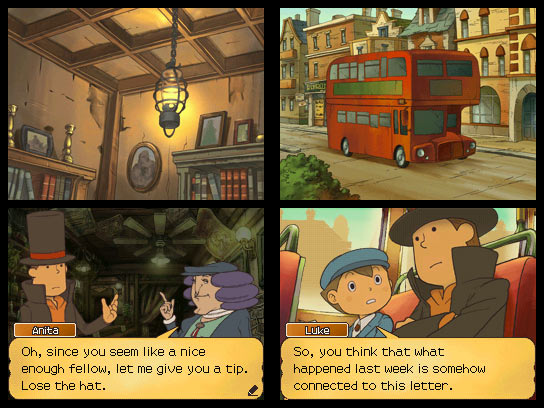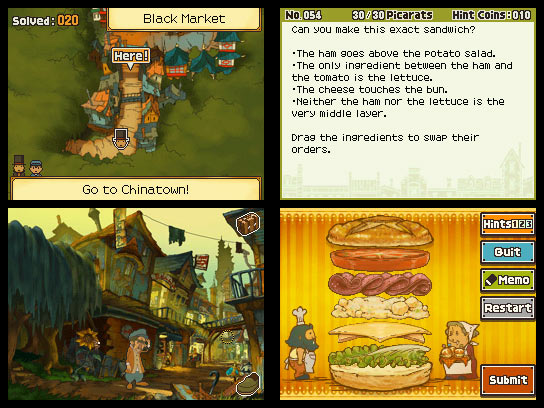Fantastic design and story, more accessible puzzles and hints, the largest amount of content yet-- both during and after the game
Disappointing mini-games
In Professor Layton and the Unwound Future, never have the stakes been so high or the story so personal. To get into specifics would spoil the story’s over-the-top climaxes and plot twists, but rest assured Layton’s third adventure is the best in the first trilogy of games, primarily because gamers get to learn more about Professor Layton’s past and a few significant events that shaped him into whom he is today. Luke also has some important moments, and series villain Don Paolo as well, but the other characters are more complementary than anything.
Yet what an exciting world Unwound Future presents, perhaps even more accessible then before since it’s based entirely in London– both in present day as well as 10 years in the future. At the game’s outset, Layton’s apprentice Luke receives a letter from himself– sent literally from the Luke 10 years in the future. This letter arrives a week after Layton and Luke attend a public demonstration of a time machine gone horribly awry. The large contraption, constructed of spinning gauges, a giant clock, pipes and an interior compartment, dramatically explodes just as it’s supposed to demonstrate transporting England’s unwitting prime minister to a different time. The explosion of metal nearly takes out the audience watching the demonstration, yet no trace is left of the scientists operating the machine nor of the prime minister. The absence of bodies raises Layton’s concern, and the letter from the future compounds things.
Thus Layton and Luke set off again, led to a functional time machine in a back-alley clock store that takes them to a dismal, dense, future London that’s run by a cartel of thugs who are directed by the most unlikely of villains. The story is touching and outlandish, comical and dramatic, and, as before, held together by (more than 160) puzzles and a vast cast of city folk of all ages, sizes and shapes.

Each of the minor characters — a few returning from previous games — are lovingly designed and bursting with personality in their appearance and the way they speak with Layton and Luke. The game’s hand-drawn puzzle artwork is equally lovely in set-up and victory screens. Whether it’s the superb visual design of characters, puzzles and cityscapes or the multiple crisp, well-animated and exciting cut scenes, this is the most visually appealing Layton game yet. Try popping in Curious Village to compare– you’ll immediately see how much polish Unwound Future has on all levels after developer Level-5 had several years’ experience with its homegrown franchise. Voice acting is also as top-notch as before, sometimes popping up at odd times but always perfectly delivered. The soundtrack — again heavy with accordion, violin, piano and bells — features a noticeable amount of recycled tunes, but the new songs are still as great as their predecessors.
Yet experience with Layton’s prequels isn’t necessary to enjoy this game. In-jokes and references are tossed back to Layton’s previous adventures, but knowledge of them isn’t required to keep up (though Layton veterans will have stronger appreciation and understanding of character relationships). Layton even keeps detailed notes of every major story point in a notebook so if you spend time away from the game you can quickly refresh the current events. In addition, every time a saved game’s loaded, a quick summary of the current setup is also given. A new indicator on the map always lets you know where you need to go next, though taking side-routes, chatting with the locals and tapping every door, window and crack adds to the adventure, as the game’s hint coins and many hidden puzzles can only be found via such exploration.

No matter the crisis or destination, though, Layton and Luke must always solve puzzles to progress. As alluded to, these puzzles are of the brain-teasing variety: logic puzzles, word riddles, math problems, mazes and sliding blocks. If you’ve played previous Layton games, very little will strike you as unheard of, and if anything, you’ll be better prepared to look for the “catch” many puzzles’ questions hide, or conversely identify when a simple, literal interpretation of the question versus convoluted hypotheticals is all that’s needed to give the right answer. These puzzles aren’t necessarily “easier” (though there’s mercifully fewer sliding block puzzles); they’re just familiar if you’ve played a previous Layton game.
Yet for anyone who’s stumped, each and every puzzle has three basic hints that can be purchased with one hint coin each, and after exhausting those, a new “super hint” that basically gives the answer can be purchased for an additional two coins. As hint coins can be exhausted and are only collected by tapping nooks and crannies in the game’s background scenery, gamers must be careful not to waste the coins.

Successfully solving puzzles moves the story along and also rewards an amount of “picarats,” which are Layton’s in-game currency for unlocking bonus items and puzzles outside the main game. These bonus features are what truly set Layton games apart from so many other DS games: the value for your real world money is enormous. In addition to the main mystery are three optional mini-games, and after completing the game’s main story, galleries, a library of character biographies (for nearly every character in the game), a soundtrack player, cutscene player and more than a dozen tough “challenge puzzles” can be unlocked– all depending on how many cumulative picarats you’ve earned. Further, a free, new puzzle can be downloaded via Nintendo’s WFC every week for a set period of time, too. This is a game that keeps on giving and is an offering few other DS adventure or puzzle games can compare to.
Unfortunately, the main quest mini-games in Unwound Future aren’t quite as fun, accessible or addictive as previous Layton titles, though they do have more levels in comparison to the prequels’ mini-games. The most appealing of Unwound Future‘s three mini-games is a trio of hand-painted storybooks with all the proper nouns (people, animals and objects) stripped out. By solving puzzles in the main quest, Layton’s awarded stickers of these objects and people that can be placed in the stories’ blanks. Only by properly placing these stickers will the stories make sense and be completed. The stories aren’t interesting and are rather inconsequential, but the Mad Libs-like completion of them is still fun.
The other two mini-games are more tiresome. One concerns creating a linear path on a map using a constrained set of arrow and jump tiles. A toy car then follows this path, and said car must pick up all the items sitting on the map and safely get to the “finish” tile. This is essentially Diabolical Box’s Hamster Diet game all over again– except with ten levels that are independently unlocked by solving certain puzzles in the main storyline.
The other mini-game features a dozen levels of its own related to a parrot Luke befriends. In the parrot’s mini-game, the parrot must deliver an item from a starting platform to a minor character standing on another platform. The parrot can only fly short distances, though, so the gamer must string a set number of ropes across specific pegs, creating a series of platforms and trampolines the parrot can land on and bounce off of in order to reach his destination. The parrot’s delivery puzzles are ridiculously challenging and annoying, and the original parrot game in the Japanese version of Unwound Future, in which the parrot learns special words to ask questions, sounds vastly more interesting.

While these lackluster mini-games are no hidden-object puzzle or “make your own tea” chemistry set (as seen in Laytons 1 and 2), Unwound Future still has a solid set of puzzles for its main adventure, and the story itself is very engaging. Given these strong positives, the lengthy main mystery (which may take gamers 10 – 12 hours alone), and all the unlockable content and puzzles, there’s little reason not to recommend Unwound Future to nearly any DS owner. The game is great fun, the puzzles “just-one-more” addictive, and the characters and story full of surprise and charm. The only question left is how long we’ll have to wait until the next trilogy of games (not to mention the Vs. Phoenix Wright title) comes to our shores.
Nintendojo was provided a copy of this game for review by a third party, though that does not affect our recommendation. For every review, Nintendojo uses a standard criteria.




 ShareThis
ShareThis






I’ve been playing this game for a bit now, and I have to say, the first one still remains my favorite. Maybe it’s just the fact that it’s the, well, the first one, but … yeah.
But I do miss the tea set from Layton 2! … and fine, the story is pretty cool in this one. I think I might just be getting tired of puzzles.